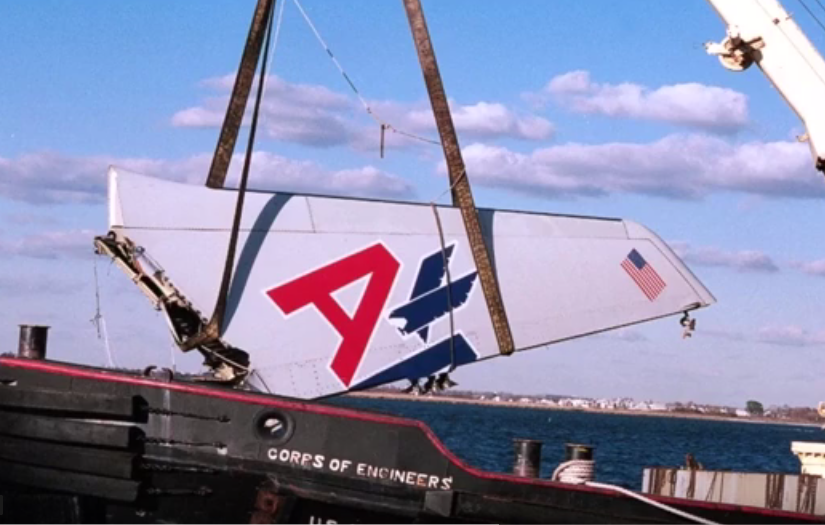
November 12, 2021
WE MADE IT. I had my doubts, but we pulled it off.
Today marks the 20th anniversary of the crash of American Airlines flight 587 in New York City. We have now gone twenty full years since the last large-scale crash involving a major U.S. carrier. This is by far the longest such streak ever.
On the sunny morning of November 12th, 2001, American 587, an Airbus A300 bound for the Dominican Republic, lifted off from runway 31L at Kennedy Airport. Seconds into its climb, the flight encountered wake turbulence spun from a Japan Airlines 747 that had departed a few minutes earlier. The wake itself was nothing deadly, but the first officer, Sten Molin, who was at the controls, overreacted, rapidly and repeatedly moving the widebody jet’s rudder from side to side, to maximum deflection. The rudder is a large hinged surface attached to the tail, used to help maintain lateral stability, and Molin was swinging it back and forth in a manner it wasn’t designed for. Planes can take a surprising amount of punishment, but airworthiness standards are not based on applications of such extreme force. In addition, the A300’s rudder controls were designed to be unusually sensitive, meaning that pilot inputs, even at low speeds, could be more severe than intended. In other words, the pilot didn’t realize the levels of stress he was putting on the aircraft. The vigor of his inputs caused the entire tail to fracture and fall off.
Quickly out of control, the plane plunged into the Belle Harbor neighborhood of Queens, a skinny section of Rockaway only a few blocks wide, with ocean on both sides. All 260 passengers and crew were killed, as were five people on the ground. It remains the second-deadliest aviation accident ever on U.S. soil, behind only that of American flight 191 at Chicago, in 1979.
Flight 587 was well known among New York City’s Dominican community. In 1996, merengue star Kinito Mendez paid a sadly foreboding tribute with his song El Avion. “How joyful it could be to go on flight 587,” he sang, immortalizing the popular daily nonstop.
This was a catastrophe to be sure. It was also the last multiple-fatality crash involving a legacy American airline, and the last on U.S. soil with more than 50 fatalities.
To be clear, there have been a number of post-2001 tragedies involving regional carriers and freighters. The worst of these were the Comair (2006) and Colgan Air (2009) crashes, in which 50 and 49 people were killed, respectively. In 2005 a young boy in a car was killed when a Southwest Airlines 737 overran a runway in Chicago, and in 2018 a woman on a Southwest Airlines 737 was killed after being partially ejected through a blown-out cabin window.
What we haven’t seen, however, is the kind of mega-crash that was once brutally routine, year after year. Take a look through the accident archives from 1970s through the 1990s. Seldom would a year go by without recording one or more front-page mishaps, with 100, 200, sometimes 300 (or more) people killed at a time. In the eighteen years prior to November, 2001, and not counting the September 11th attacks, the American legacies, which at the time included names like Pan Am, TWA and Eastern, suffered ten major crashes. The idea that we could span two full decades without such a disaster was once unthinkable.
It’s especially remarkable when you consider there are nearly twice as many planes, carrying twice as many people, as there were in 2001. Since then, the mainline American carriers have safety transported more than twenty billion passengers. Today they operate over four thousand Airbuses and Boeings between them, completing tens of thousands of flights weekly. The streak also takes in those dark years of the early 2000s, when pretty much all of the big carriers were in and out of bankruptcy, fighting for survival. Not to mention the dire challenges of the last twenty months, brought on by the COVID-19 pandemic. Best of times, worst of times. All it would have taken is one screw-up, one tragic mistake. Yet here we are.
When we expand the context globally, the trend is even more astonishing. Between the 1980s and the mid-2000s there were dozens of air disasters worldwide — sometimes five or more in a year. In 1985 alone, twenty-seven major crashes — twenty seven! — killed almost 2,400 people.
How we got here is mainly the result of better training, better technology, and the collaborative efforts of airlines, pilot groups, and regulators. We’ve engineered away what used to be the most common causes of accidents. Yes, we’ve been lucky too, and the lack of a headline tragedy does not mean we should rest on our laurels. Complacency is about the worst response we could have. Air safety is all about being proactive — even a little cynical. Our air traffic control system needs upgrades, our airports need investment. Terrorism and sabotage remain threats, and regulatory loopholes need closing. The saga of the 737 MAX has been a cautionary window into just how fortunate we’ve been, and exposed some glaring weaknesses.
Duly noted, but a congratulatory moment is, for today, well earned. This isn’t a minor story.
Almost nobody in the media is paying attention, trust me. Crashes, not an absence of them, make the news. Call it the silent anniversary, but there’s no overstating it: we have just passed one of the most significant milestones in commercial aviation history.
U.S. Airline Accidents With 50 or More Fatalities, by Year
1970: 1
1971: 1
1972: 1
1973: 2
1974: 4
1975: 1
1976: 0
1977: 2
1978: 1
1979: 2
TOTAL 1970s : 15
1980: 0
1981: 0
1982: 2
1983: 0
1984: 0
1985: 3
1986: 0
1987: 1
1988: 1
1989: 2
TOTAL 1980s: 9
1990: 0
1991: 0
1992: 0
1993: 0
1994: 2
1995: 1
1996: 2
1997: 0
1998: 0
1999: 0
TOTAL 1990s: 6
2000: 1
2001: 5
Since 2001: 0
History’s Ten Worst Disasters Involving U.S. Carriers
1. 1977. Two Boeing 747s, operated by Pan Am and KLM, collide on a foggy runway at Tenerife, in Spain’s Canary Islands killing 583 people, 335 of them on the Pan Am plane. The KLM jet departed without permission and struck the Pan Am jet as it taxied along the same runway. Confusion over instructions and a blockage of radio transmissions contributed to the crash.
2. 1979. As an American Airlines DC-10 lifts from the runway at Chicago’s O’Hare airport, an engine detaches and seriously damages the wing. Before its crew can make sense of the situation, the plane rolls 90 degrees and disintegrates in a fireball beyond the runway, killing 273. The engine pylon design and airline maintenance procedures are faulted by investigators, and all DC-10s are temporarily grounded.
3. 1988. Two Libyan agents are later held responsible for planting a bomb aboard Pan American flight 103, which blows up in the night sky over Lockerbie, Scotland, killing 270 people, including 11 on the ground.
4. 2001. American Airlines 587 goes down outside JFK airport in New York killing 265.
5. 1985. An Arrow Air DC-8 crashes after takeoff from Gander, Newfoundland, killing 256 people, most of them U.S. military personnel returning from Egypt. The disaster is blamed on ice contamination of the jet’s wings.
6. 1996. Shortly after departure, a fuel tank explosion destroys TWA flight 800, a 747 carrying 230 passengers and crew from JFK to Paris. There are no survivors.
7. 1995. A navigational error causes American Airlines flight 965, bound from Miami, to Cali, Colombia, to wander off course during arrival. The 757 hits a mountain 25 miles from its destination. There are four survivors of the plane’s 163 occupants.
8. 1987. A Northwest Airlines MD-80 crashes on takeoff at Detroit. The pilots had neglected to properly set the flaps and slats, and for reasons unknown the jet’s warning system failed to alert them. A four year-old girl was the only survivor among the 155 passengers and crew.
9. 1982. A Pan Am 727 goes down seconds after departing from New Orleans, Louisiana. There are 153 fatalities, including eight people on the ground. The plane had taken off into a rare and deadly microburst — a localized, high-power windshear produced by a violent thunderstorm.
10. 1978. A Pacific Southwest Airlines (PSA) 727 collides over San Diego with a small private plane. A total of 143 people die including seven on the ground.
Related Stories:
AMERICA’S DEADLIEST AIR DISASTER, 40 YEARS LATER
THE HORROR AND ABSURDITY OF HISTORY’S WORST CRASH






